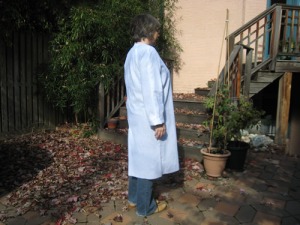This started as a comments response to my post A muslin story, but then it just got long enough for its own post, so here it is. Thank you to Robin and Sue and Elizabeth for their thoughts!
I cut the pattern, Burda 3-2009-112 in a 46, the largest size in the pattern, partly because it is the size my measurements indicated and partly because my tracing paper is too thick to see the lighter-weight tracing lines of the smaller sizes very well! But I think that truly I’m a Burda 44, at the largest, having made a skirt not too long ago from Burda in the 44 which fit well enough with some wiggle room at the waist line. For my next Burda project, I’ll get lighter-weight tracing paper! I was really surprised that this is so roomy in the bust in particular — I am a DD so hardly any pattern that is at all fitted is a good fit without a full-bust adjustment. (I’m a 46 based on my high-bust measurement, BTW, not my full bust measurement.)
I got most of my pattern pieces laid out last night — my fabric is narrower than what Burda recommends, but JUST long enough to eke it all out. Also, I figured out what pieces need interfacing and wrote up a little to-do-list to make sure I get everything cut out that needs cutting out; this part is the dullest for me, I think.
I am going to leave my coat unlined, per the pattern, and I haven’t figured out how to finish the seams. I have a serger but it needs to go to the spa to get fixed up. I think I just did a zigzag stitch on the skirt that I made with the same fabric a few years ago, and that has held up. This coat will not get laundered, it’ll always get dry-cleaned and/or steamed and brushed. I don’t want to spend the time to add seam-binding, and as this is not heavyweight wool I also worry that seam-binding would show through as lumps on the outside.
I also need to trace out and cut out the pattern pieces for the pockets. I’m going to wait on tracing out and cutting out the belt pieces, since I don’t have the hardware for it yet. Also, if I hate the coat, I don’t want to spend the extra time and material on a belt for it; sewing a belt isn’t hard enough to want to try it out for practice, and I don’t want to buy any new equipment if I don’t have to. I will do the pockets in any event, I think, because I am trying to learn pockets.
I have an interfacing question — for the collar pieces, I have silk organza, which I think will work nicely and which I’ve worked with before, for waistband interfacing. But I don’t have a large enough piece of organza for the large facing piece that goes down the inside front of the coat and turns over for the bottom of the collar. I do have a lightweight woven interfacing that feels like rayon that I think I’d like to use, but I’d love some informed feedback if you have it to offer, so here goes:
This interfacing is intended to be ironed on, but then in washing or steaming the very lightweight amount of glue comes off or something, and so ultimately it is not fused to the fabric. I’m guessing this means it’s normally intended for lighter-weight fabrics that shift a lot, which is not what I’m working with — my wool is a medium-weight fabric and very easy to work with, it’s not shifty at all.
Also, in storing this rayon interfacing, it’s gotten pretty wrinkled.
So, first question — should I put aside this interfacing and go with something else that’s not a fusible? (the wool fabric is a crepe, I think, with a slightly nubby texture, and as a result I don’t want to use a fusible interfacing). I have some other interfacings in house that I could use instead; I am such an interfacing n00b that I don’t have any real sense of what’s best.
Second question — if I do decide to use this interfacing, what should I do to try to de-wrinkle it, keeping in mind that I can’t iron it because of the glue on one side? Right now I’ve got it draped over a bookcase in the hopes that the wrinkles will fall out a bit.
Third question — is the wrinkling a bad sign that this is not a good interfacing for this project? Wool crepe is not excessively wrinkly, but wouldn’t one of the main points of interfacing be to keep the fabric from getting wrinkly/mashed down?
Okay! Thanks for thoughts and advice!














